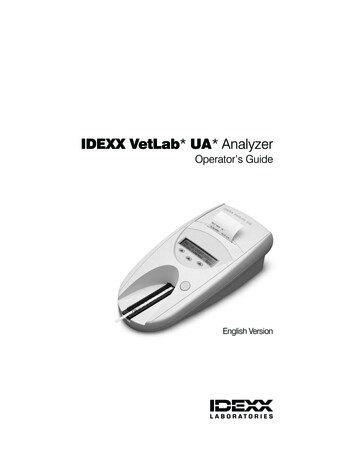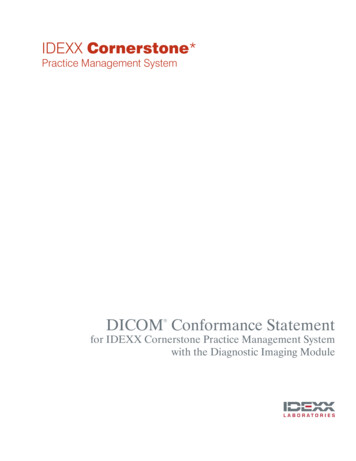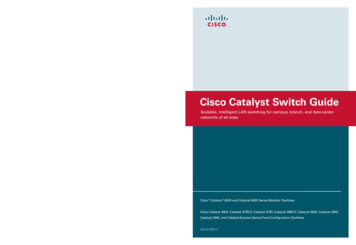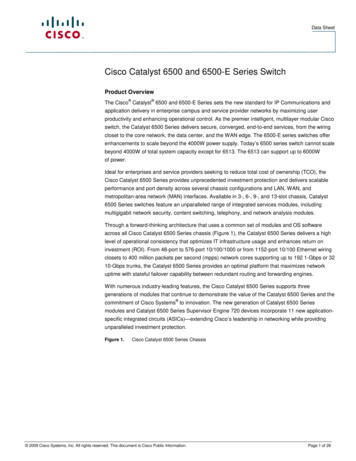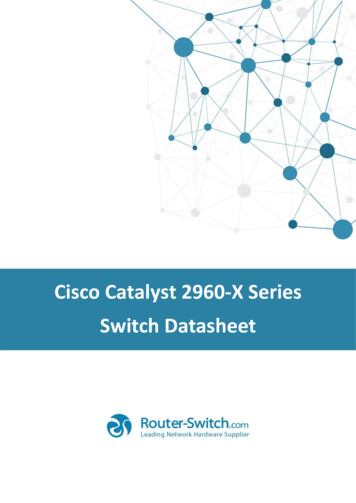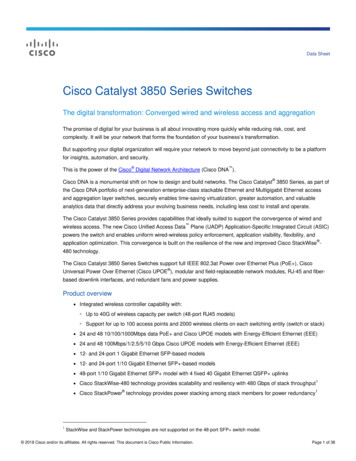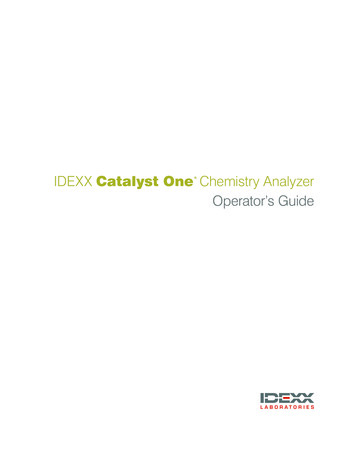
Transcription
IDEXX Catalyst One* Chemistry AnalyzerOperator’s Guide
Proprietary Rights NoticeInformation in this document is subject to change without notice. Companies, names and data used inexamples are fictitious unless otherwise noted. No part of this document may be reproduced or transmittedin any form or by any means, electronic, mechanical or otherwise, for any purpose, without the expresswritten permission of IDEXX Laboratories. IDEXX Laboratories may have patents or pending patentapplications, trademarks, copyrights or other intellectual or industrial property rights covering this documentor subject matter in this document. The furnishing of this document does not give a license to these propertyrights except as expressly provided in any written license agreement from IDEXX Laboratories. 2015 IDEXX Laboratories, Inc. All rights reserved. 06-0001252-01*IDEXX VetLab, Catalyst, Catalyst One, IDEXX VetTrol, SmartLink, IDEXX InterLink, IDEXX SmartService,SNAP, and 4Dx are trademarks or registered trademarks of IDEXX Laboratories, Inc. in the United Statesand/or other countries. All other product and company names and logos are trademarks of their respectiveholders.2
ContentsPreface.5Safety Precautions.5Performance Precaution.5Care of the Analyzer.5International Symbol Descriptions.6Other Symbols.7Getting Started.8Introduction.8Catalyst One Components.9Analyzer Status.10Responding to an Alert.11Installing the Catalyst One Analyzer.11Catalyst One Analyzer Consumables.12Compatible Species.13*Using the Catalyst One Analyzer.14Analyzing Samples.14Slide Handling.14Diluting Samples.14Viewing and Printing Test Results .16Outside of Reportable Range Samples .17Modifying the Settings on the Analyzer.18Modifying the Sound Settings‡.18Entering Standby Mode.18Exiting Standby Mode.18Sample Preparation and Storage.19Supported Sample Types for Catalyst* CLIPs and Slides.19Preparing Samples for Use on the Catalyst One Analyzer.20Proper Sample Cup Volume.22Sample Inspection After Centrifugation.22Sample Storage.23Quality Control.24Overview.24Quality Control Materials .24Quality Control CLIPs and Slides.25Preparing Control Fluid.26Running Quality Control.273
Maintenance.28Overview.28Upgrading the Software.28Cleaning the Internal Components of the Analyzer.28Cleaning the Outside of the Analyzerand the Sample Drawer.29Emptying the Waste Drawer.29Appendices.30Chemistry Descriptions.30Medical Protocol Descriptions.51Profile Selection.56Differences in Results.57Technical Specifications.57IDEXX Technical Support Contact Information.584
PrefaceSafety PrecautionsNote: If the equipment is used in a manner other than specified, the protection provided by theequipment may be impaired.The analyzer does not contain any user-serviceable components. DO NOT disassemble.Line voltage for the Catalyst One AC power adapter is 100–240 V AC, 50–60 Hz. Be sure to plug allequipment into properly grounded electrical outlets.Use only the AC power adapter and AC power cable supplied.Disconnect the AC power cable from the wall outlet if the: AC power cable or the DC power cord becomes frayed or otherwise damaged. AC power adapter is exposed to water or other liquids.Performance PrecautionDo not use certain liquids, aerosols (such as canned air), solvents, ammonia, and other substanceson or near the analyzer which could influence results.Care of the AnalyzerIt is recommended that you do not stack other equipment or containers on top of the analyzer.Keep analyzer away from sources of heat or flames.PROTECT your equipment from damp conditions, wet weather, or liquid spills.Take care not to spill water or other liquids on the unit.DO NOT use solvents, ink markers, sprays containing volatile liquids, or polish on the analyzer as itmay damage the outer case. Clean only with a mild soap and slightly moist cloth and only when theanalyzer is not in use.Clean only with a mild soap and slightly moist cloth and only when the analyzer is not in use.5
PrefaceInternational Symbol DescriptionsInternational symbols are often used on packaging to provide a pictorial representation of particularinformation related to the product (such as expiration date, temperature limitations, batch code,etc.). IDEXX Laboratories has adopted the use of international symbols on our analyzers, productboxes, labels, inserts, and manuals in an effort to provide our users with easy-to-read information.SymbolDescriptionSymbolDescriptionUse byA utiliser avantVerwendbar bisUsare entroUsar antes de使用期限Temperature limitationTempérature limiteZulässiger TemperaturbereichTemperatura limiteLimitación de temperatura保存温度(下限)Batch code (Lot)Code de lot (Lot)Chargenbezeichnung (Partie)Codice del lotto (partita)Código de lote (Lote)ロット番号Upper limit of temperatureLimite supérieure de températureTemperaturobergrenzeLimite superiore di temperaturaLimite superior de temperatura保存温度(上限)Serial numberNuméro de sérieSeriennummerNumero di serieNúmero de serieシリアル番号Consult instructions for useConsulter la notice d’utilisationGebrauchsanweisung beachtenConsultare le istruzioni per l’usoConsultar las instrucciones de og numberNuméro catalogueBestellnummerNumero di catalogoNúmero de catálogo製品番号Keep away from sunlightConserver à l’abri de la lumièreVor direkter SonneneinstrahlungschützenMantener alejado de la luz solarTenere lontano dalla luce diretta del sole遮光してください。Authorized Representative in theEuropean CommunityReprésentant agréé pour la C.E.E.Autorisierte EG-VertretungRappresentante autorizzato nellaComunitá EuropeaRepresentante autorizado en laComunidad EuropeaEC内の正規販売代理店WEEE Directive 2002/96/ECDirective 2002/96/CE (DEEE)WEEE-Richtlinie 2002/96/EGDirectiva 2002/96/CE RAEEDirettiva RAEE 2002/96/CE廃電気電子機器指令(WEEE lerDitta produttriceFabricante製造元Biological risksRisques biologiquesBiogefährlichRischi biologiciRiesgos biológicos生物学的リスクCaution, consult accompanyingdocumentsAttention, consulter les documentsjointsAchtung, BegleitdokumentebeachtenAttenzione, consultare ladocumentazione allegataPrecaución, consultar ladocumentación ��。Do not reuseUsage uniqueNicht wiederverwendenNo reutilizarwNon riutilizzare再利用しないでください。26
PrefaceSymbolDescriptionSymbolDescriptionCaution, hot surfaceAttention, surface très chaudePrecaución, superficie calienteVorsicht, heiße OberflächeAttenzione, superficie rovente高温注意Electrostatic-sensitive deviceAppareil sensible aux chargeséléctrostatiquesDispositivo sensible a descargaselectrostáticasGerät ist sensibel auf elektrostatischeLadungDispositivo sensibile alle る装置Keep dryConserver dans un endroit secMantener secoVor Nässe schützenTenere al riparo ileFrágilZerbrechlichFragile取扱注意This side upHautEste lado hacia arribaDiese Seite nach obenAltoこの面を上にする。Date of manufactureDate de productionFecha de producciónHerstelldatumData di produzione製造年月日:Other SymbolsSymbolDescriptionUSB symbolSymbolDescriptionEthernet/network symbolWireless symbol‡‡Feature coming soon7
Getting StartedIntroductionWelcome to IDEXX’s next-generation chemistry analyzer—the Catalyst One* Chemistry Analyzer.The Catalyst One analyzer’s flexible test menu allows you to monitor the health status of specificorgans, recheck values over time, customize profiles by adding single tests to CLIPs. You can evenrun up to 25 tests on a single sample (for a complete list of the individual slides and CLIPs available,see page 12).The Catalyst One analyzer is for veterinary use only.IDEXX VetLab* Station ConnectivityThe Catalyst One analyzer is part of the IDEXX VetLab* suite of analyzers, all of which connectto the IDEXX VetLab Station (IDEXX’s laboratory information management system). Connectingmultiple analyzers to the IDEXX VetLab Station helps you attain a comprehensive picture of yourpatient’s health, with the ability to view test results from multiple analyzers on a single report,determine disease progression with parameter-trending capabilities, and more.By connecting the Catalyst One analyzer to the IDEXX VetLab Station, you can: Automatically review patients’ prior results on every printout for easy comparison. Improve client communications with illustrated diagnostic or treatment progress printouts. Link to expert descriptions and common causes of abnormal values. Print information to help explain the significance of results to your clients. Allow new staff to train independently. Learn proper protocols and tips for best techniques.IDEXX Dry-Slide TechnologyThe Catalyst One analyzer uses dry-slide technology—the most accurate technology available forin-house testing. Dry-slide technology uses layers to remove impurities for the most accurate resultsfrom even compromised samples.Patient sample is applied tothe top of the spreading layerSpreading layerSample is distributed evenlyFiltering layerFilters out substances that interfere with resultsReagent layerReagent reacts with sampleIndicator layerReacted sample collects for spectral analysisSupport layerOptical interface8
Getting StartedHow it WorksThere are several important steps that the analyzer performs in order to present the results ofa sample. Once the slides and sample have been inserted into the analyzer, the Catalyst Oneanalyzer incubates the slides. Then, if using a Catalyst* whole blood separator, the plasma isseparated from a whole blood sample. The sample is then accurately dispensed onto the slides,the analyzer measures the color development of the slide, and then all used materials are removedfrom the analyzer.Catalyst One ComponentsFront of the AnalyzerSide doorStatus LEDStart buttonLock lightSample drawerWaste drawerInside of the Sample DrawerNote: This picture depicts where the sample cup and whole blood separator should be placed inthe sample drawer. Do not load a whole blood separator AND a sample cup for a single run.Other reagentconsumablesPipette tipsWhole HBR) reagentconsumable/automateddilution cups9
Getting StartedSide of the AnalyzerCarousel cover(shown closed)Side doorLever to raisecarousel coverBack of the AnalyzerPower portEthernet portAnalyzer StatusThe light-emitting diode (LED) indicator on the front panel of the Catalyst One analyzer indicates theanalyzer’s status.Note: You can also view the analyzer status by viewing its icon on the IDEXX VetLab Station Homescreen.LED ColorDescriptionGreen (steady)READY; analyzer is ready to process samples or performmaintenance tasksGreen (pulse)STANDBY MODEYellow (steady)IN PROCESS; analyzer is processing a sample or performinganother activityYellow (pulse)Analyzer is waiting for the user to begin processing a sample afterreceiving the patient information from the IDEXX VetLab StationRed (flashing)ERROR; an error has occurred; review error or alert messages onthe IDEXX VetLab Station10
Getting StartedResponding to an AlertWhen the analyzer experiences a problem, an alert message appears on the upper right side of theIDEXX VetLab Station title bar, the LED on the front panel of the Catalyst One analyzer flashes red,and the Catalyst One icon on the IDEXX VetLab Station Home screen appears with an Alert status.To View an AlertDo one of the following: Tap the Catalyst One icon on the IDEXX VetLab Station Home screen. Tap the alert message in the title bar to display the alert message. Follow the instructionsdisplayed in the alert message.Installing the Catalyst One AnalyzerThe Catalyst One analyzer works in conjunction with the IDEXX VetLab Station.To Install the Catalyst One Analyzer1.Before you unpack the analyzer, choose an optimum location for the instrument. The analyzershould be placed on a level surface in a well-ventilated area away from obvious sources ofheat, direct sunlight, cold, humidity, or vibrations. For optimum results, room temperatureshould be at 15 C–30 C (59 F–86 F) and relative humidity at 15%–75%.IMPORTANT: Ensure proper ventilation. The analyzer’s cooling vents are in the base and theback.2.Connect the analyzer to the router:––If you are planning to connect the device wirelessly to an IDEXX VetLab* Station,proceed to step 3 (wireless-capable router required).‡OR––If you are connecting the device to an IDEXX VetLab Station using a wired router,connect the device to a numbered port on the router using an Ethernet cable(provided).Note: For more information about connecting your analyzer to the router, see the installationinstructions that accompanied your router.3.Power on the Catalyst One analyzer. Once the Catalyst One icon displays on the IDEXXVetLab Station Home screen, your connections are complete.Note: If the Catalyst One icon does not appear on the IDEXX VetLab Station Home screenwithin 3 minutes, contact IDEXX Technical Support for assistance.‡Feature coming soon11
Getting StartedCatalyst One Analyzer ConsumablesThe following consumables are available for use with the Catalyst One analyzer: Alkaline PhosphataseALKP Alanine AminotransferaseALT AmylaseAMYL Aspartate AminotransferaseASTBlood Urea NitrogenBUN CalciumCa CholesterolCHOL Creatine KinaseCKCreatinineCREAIndividual SlidesEquine 15 CLIP QC CLIPChem 10 CLIPALB Lyte 4 CLIPChem 15 CLIPAlbuminUPC PanelAbbreviationNSAID 6 CLIPChemistryChem 17 CLIPCLIPs, Panels, and Slides GGT GlucoseGLU PotassiumKLactateLACLactate iaNH3PhenobarbitalPHBRInorganic PhosphatePHOS Total BilirubinTBIL Total ProteinTP Total T4TT4 TriglyceridesTRIG Urine CreatinineUCRE Urine ProteinUPRO Uric AcidURIC 12
Getting StartedCompatible ardSea TurtlesBovine (beef cattle, dairy cow)LlamaSheepAvian (budgerigar, cockatoos[grey cheek, Moluccan, umbrella],cockatiel, canary, conure, macaw[blue and gold, hyacinth, scarlet],parrots [Amazon blue, Amazonyellow, eclectus, African specific intervals are available for these species. All other species are qualified as “other.”13
Using the Catalyst One* AnalyzerAnalyzing SamplesThere are four different work flows that can be used to analyze a sample on the Catalyst One*analyzer: Analyze Sample Button—Use this work flow if you do not have a practice managementsystem connected to your IDEXX VetLab* Station via IDEXX SmartLink* or IDEXX InterLink*technology. Pending List or Census List—Use one of these work flows if you have a practicemanagement system connected to your IDEXX VetLab Station via IDEXX SmartLink or IDEXXInterLink technology. Using this work flow will save you time because you do not need toenter the client and patient information into the IDEXX VetLab Station (since it has alreadybeen entered into your practice management system). Ready to Run Icon—Use this work flow if you initiated the sample run using one of theother work flows, but the analyzer was busy at the time and the sample could not be runimmediately.For more information on these work flows, see the IDEXX VetLab Station Operator’s Guide.Slide HandlingThe Catalyst One analyzer allows you to run up to 25 tests on a single sample. Before you begin,please take note of the following: Frozen CLIPs/panels/slides can be run on the Catalyst One analyzer (no thawing required). Most CLIPs/slides should be loaded within 5 minutes of opening their foil packaging. The Lyte4 CLIP should be loaded within 2 minutes of opening its foil packaging. If you are running a Lyte 4 CLIP, be sure to load it in the sample drawer before any otherCLIPs or slides.Diluting SamplesDilutions should only be performed when a test value is outside the reportable range or when thesample contains interfering substances (e.g., medications) that cause a nonlinear or invalid result.The Catalyst One analyzer supports automated dilutions (the analyzer mixes the sample anddiluent for you) and manual dilutions (you prepare the dilution outside of the analyzer). Select theappropriate option on the Identify Sample screen.Remember the following important notes when diluting samples for analysis on the Catalyst Oneanalyzer: Only dilute tests with results outside of the reportable range. Diluting tests with results in thenormal range may produce invalid results. All chemistries should be analyzed first on the undiluted sample. Some analytes, such as GGTand total bilirubin, have low serum/plasma concentrations. These analytes may be diluted outeven with the lowest dilution. Dilute the remaining sample and analyze any chemistries thatwere outside of the reportable range on the first analysis. Perform a dilution only when a test value is accompanied by a greater than symbol ( ) ordashes (---) on the patient report or when the analyzer informs you a dilution is necessary toreceive accurate results.14
Using the Catalyst One* Analyzer Use the proper diluent material for your sample type.––For plasma and serum samples, use normal saline.––IDEXX does not recommend manually diluting whole blood in a Catalyst* whole bloodseparator—only dilute the separated plasma.––For urine, use Catalyst* Urine P:C Diluent. Use an accurate measuring device, such as a calibrated pipette or syringe. For best results, start with a 1:2 dilution (1 part sample to 1 part diluent)—do not exceed 10parts diluent. Do not dilute samples that are undergoing ammonia, phenobarbital, fructosamine, total T4, orelectrolyte testing. Do not dilute small samples to achieve a minimum sample volume. Such dilutions on normalanalyte concentration cannot be read accurately. When dilution is needed to determine someanalytes at very high concentration, the sample should be diluted manually. An automated dilution run will be canceled if:––There is insufficient diluent/sample volume.––There are too many slides in the run.Minimum Sample Volume for DilutionsThe minimum sample volume varies based on the dilution factor and the number of slides that arebeing diluted (see table below).Parts Sample Parts Diluent Diluent RatioMaximumNumber ofSlides perDilutionMinimum Sample VolumeSerum, Plasma,or UrineWhole BloodDiluentVolume1 1 1:25155 µL700 µL300 µL1 3 1:410130 µL700 µL300 µL1 5 1:610130 µL700 µL300 µL1 9 1:1010100 µL700 µL300 µLPreparing Manual DilutionsTo Prepare a 1:2 Dilution1.Accurately measure the desired amount of sample to be diluted and gently transfer it to asample cup.2.Accurately measure an equal amount of diluent and transfer it to the sample collected in step 1.3.Thoroughly mix the sample and diluent.4.Analyze the sample.15
Using the Catalyst One* AnalyzerTo Prepare Dilutions Greater Than 1:2If additional dilutions beyond 1:2 are necessary, always begin with the original, undiluted sample.Then, incrementally increase the parts diluent as indicated in the dilution chart (below).Volumes are for example only. Parts Sample Parts Diluent Total Parts (Dilution Factor)Parts Sample1 (100 µL)Parts DiluentTotal Parts(Dilution Factor)01 (undiluted sample)1 (100 µL)1 (100 µL)21 (100 µL)2 (200 µL)31 (100 µL)3 (300 µL)41 (100 µL)4 (400 µL)51 (100 µL)5 (500 µL)61 (100 µL)6 (600 µL)71 (100 µL)7 (700 µL)81 (100 µL)8 (800 µL)91 (100 µL)9 (900 µL)101 (100 µL)10 (1,000 µL)11Viewing and Printing Test ResultsAnalyzer results are automatically returned to the IDEXX VetLab Station and recorded in theappropriate patient’s record. The diagnostic results report is a comprehensive report of all the testresults specified in a laboratory request for that patient on a specific day.Patient test results can be printed automatically each time a set of results are returned or you canmanually print the results when needed.For more information about how to view and print test results, see the IDEXX VetLab StationOperator’s Guide.16
Using the Catalyst One* AnalyzerOutside of Reportable Range SamplesOccasionally a test value may be outside the analyzer’s reportable range capability. The test valuemay be greater than (“ ”) the reportable range, or interfering substances in the sample may becausing a nonlinear or invalid result. See the following chart for reportable ranges on individualchemistries. If a value is required, it will be necessary to dilute the sample and repeat the test.ChemistryALBU.S. Units0.1–6.0 g/dLS.I. UnitsFrench Units1–60 g/L1–60 g/LALKP10–2,000 U/L10–2,000 U/L10–2,000 U/LALT10–1,000 U/L10–1,000 U/L10–1,000 U/LAMYL5–2,500 U/L5–2,500 U/L5–2,500 U/LAST0–1,083 U/LBUN/UREACaCHOLCK0.6–46.4 mmol/L1.0–16.0 mg/dL0.25–4.00 mmol/L6–520 mg/dL0.16–13.44 mmol/L10–2,036 U/LCl50–160 mmol/LCREA0–1,083 U/L2–130 mg/dL10–2,036 U/L50–160 mmol/L0–1,083 U/L0.034–2.730 g/L10–160 mg/L0.06–5.20 g/L10–2,036 U/L50–160 mmol/L0.1–13.6 mg/dL9–1202 µmol/LFRU100–1,000 µmol/L100–1,000 µmol/L100–1,000 µmol/LGGT0–952 U/L0–952 U/L0–952 U/LGLU10–686 mg/dLKLAC0.56–38.11 mmol/L1.0–136.0 mg/L0.10–6.86 g/L0.8–10 mmol/L0.8–10 mmol/L0.8–10.0 mmol/L0.50–12.00 mmol/L0.50–12.00 mmol/L0.50–12.00 mmol/LLDH50–2,800 U/L50–2,800 U/L50–2,800 U/LLIPA10–6,000 U/L10–6,000 U/L10–6,000 U/LMg0.5–5.2 mg/dLNa85–180 mmol/L85–180 mmol/L85–180 mmol/L0–950 µmol/L0–950 µmol/L0–950 µmol/L5–55 µg/mL5–55 µg/mL5–55 µg/mLNH3PHBR†0.21–2.17 mmol/LPHOS0.2–16.1 mg/dLTBIL0.1–27.9 mg/dL2–477 µmol/LTP0.5–12.0 g/dL5–120 g/LTRIG10–375 mg/dL0.06–5.19 mmol/L0.11–4.23 mmol/L5.0–52.0 mg/L2.00–161.00 mg/L1.0–279.0 mg/L5–120 g/L0.10–3.75 g/LTT4 (canine)0.5–10.0 µg/dL6.43–128.70 nmol/L6.43–128.70 nmol/LTT4 (feline)0.5–20.0 µg/dL6.4–257.4 nmol/L6.4–257.4 nmol/L6–350 mg/dL0.06–3.50 g/L0.06–3.50 g/LUPRO5–400 mg/dL0.05–4.00 g/L0.05–4.00 g/LURIC0.1–20 mg/dLUCRE†6–1,190 µmol/L1–200 mg/L1 µg/mL 4.31 µmol/L17
Modifying the Settings on the AnalyzerModifying the Sound Settings‡The analyzer will beep when it encounters an alert. You can modify the Sound settings to turn thesound off or adjust its volume.1.Tap Instruments on the IDEXX VetLab Station Home screen.2.Tap the Catalyst One side tab.3.If you do not want the analyzer to make any sounds, tap Off in the Sound area.OR4.If you want the volume of the sound to be quiet, tap Low in the Sound area.OR5.If you want the volume of the sound to be loud, tap High in the Sound area.Entering Standby ModeYou can modify the settings of the analyzer so that it enters Standby mode at a certain time eachday or put it in Standby mode immediately.1.Tap Instruments on the IDEXX VetLab Station Home screen.2.Tap the Catalyst One side tab.3.If you do not want the analyzer to ever enter Standby mode, tap Never in the Standby area.OR4.If you want the analyzer to enter Standby mode at a certain time each day, tap Daily in theStandby area and then select the desired start time from the available drop-down list.OR5.If you want the analyzer to enter Standby mode immediately, tap Now in the Standby area.Exiting Standby ModeYou can set the analyzer to exit Standby mode at a certain time each day or immediately.1.Tap Instruments on the IDEXX VetLab Station Home screen.2.Tap the Catalyst One side tab.3.If you want the analyzer to exit Standby mode at a certain time each day, tap Daily in the ExitStandby area and then select the desired start time from the available drop-down list.OR4.‡If you want the analyzer to exit Standby mode immediately, tap Now in the Exit Standby area.Feature coming soon18
Sample Preparation and StorageSupported Sample Types for Catalyst* CLIPs and SlidesLithiumHeparin-TreatedPlasmaChem 17 CLIPN/A Chem 15 CLIPN/A Chem 10 CLIPN/A Equine 15 CLIPN/A NSAID 6 CLIPN/A UPC PanelN/ALyte 4 CLIPN/A AlbuminALB Alkaline PhosphataseALKP Alanine AminotransferaseALT AmylaseAMYL Aspartate AminotransferaseAST Blood Urea NitrogenBUN/UREA CalciumCa CholesterolCHOL Creatine KinaseCK CreatinineCREA Fructosamine (part number 99-0000131)FRU Fructosamine (part number 99-0003341)FRU Gamma-glutamyltransferaseGGT GlucoseGLU LactateLACLactate alate-TreatedPlasmaCLIPs/SlidesSerumUntreated WholeBl
IDEXX VetLab Station title bar, the LED on the front panel of the Catalyst One analyzer flashes red, and the Catalyst One icon on the IDEXX VetLab Station Home screen appears with an Alert status. To View an Alert Do one of the following: Tap the Catalyst One icon on the IDEXX VetLab Station Home screen.

